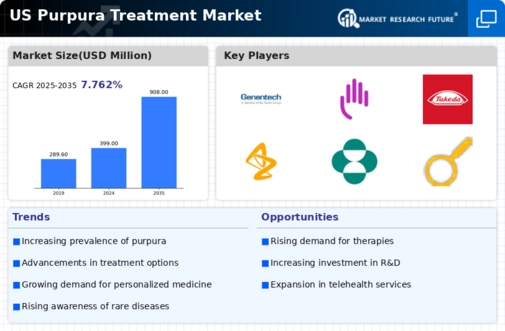Rising Healthcare Expenditure
The increasing healthcare expenditure in the US is a pivotal driver for the purpura treatment market. As healthcare budgets expand, there is a greater allocation of resources towards the development and accessibility of advanced treatment options for various medical conditions, including purpura. According to recent reports, healthcare spending in the US is projected to reach approximately $6 trillion by 2027, which indicates a growing commitment to improving patient care. This financial investment facilitates the introduction of new therapies and technologies, enhancing the overall treatment landscape for purpura. Consequently, as healthcare systems prioritize effective management of blood disorders, the purpura treatment market is likely to experience substantial growth, reflecting the increasing demand for comprehensive treatment solutions.
Growing Awareness and Education
The surge in awareness and education regarding purpura and its treatment options is a significant driver for the purpura treatment market. Initiatives aimed at educating both healthcare professionals and the general public about the symptoms and management of purpura have led to earlier diagnosis and treatment. Campaigns by health organizations and patient advocacy groups have been instrumental in disseminating information, which appears to have resulted in a higher rate of consultations and treatment-seeking behavior among patients. This heightened awareness not only empowers patients but also encourages healthcare providers to stay updated on the latest treatment protocols. As a result, the purpura treatment market is likely to benefit from an informed patient population that actively seeks effective therapies.
Advancements in Treatment Modalities
Innovations in treatment modalities are significantly influencing the purpura treatment market. The development of novel therapies, including monoclonal antibodies and targeted therapies, has transformed the landscape of purpura management. These advancements not only enhance treatment efficacy but also improve patient outcomes, which is crucial in a market characterized by diverse patient needs. For instance, recent studies have shown that new biologic agents can reduce the frequency of bleeding episodes in patients with chronic purpura. As these treatment options become more widely available, healthcare providers are likely to adopt them, thereby driving growth in the purpura treatment market. The ongoing research and development efforts in this area suggest a promising future for innovative therapies that could further revolutionize treatment approaches.
Increasing Prevalence of Purpura Cases
The rising incidence of purpura cases in the US is a notable driver for the purpura treatment market. Recent data indicates that the prevalence of various forms of purpura, including idiopathic thrombocytopenic purpura, has been on the rise, affecting a significant portion of the population. This increase is likely attributed to factors such as heightened awareness and improved diagnostic capabilities. As more individuals are diagnosed, the demand for effective treatment options escalates, thereby propelling the purpura treatment market forward. Furthermore, the growing aging population, which is more susceptible to blood disorders, contributes to this trend. The purpura treatment market is expected to expand as healthcare providers seek innovative therapies to address the needs of this increasing patient demographic.
Regulatory Support for Innovative Therapies
Regulatory support for innovative therapies is emerging as a crucial driver for the purpura treatment market. The US Food and Drug Administration (FDA) has been increasingly favorable towards expedited approval processes for breakthrough therapies, particularly in the realm of rare diseases and blood disorders. This regulatory environment encourages pharmaceutical companies to invest in research and development of new treatment options for purpura. The potential for faster market entry of novel therapies not only stimulates competition but also enhances patient access to cutting-edge treatments. As regulatory frameworks continue to evolve, the purpura treatment market is poised for growth, driven by the introduction of innovative solutions that address unmet medical needs.

















Leave a Comment